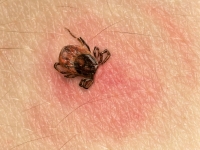Benefits Of Micronutrients In Lyme Disease-Part II
With the approaching summer season, we discussed some aspects of vector borne diseases mainly, Lyme disease in the last section of the Health Science News Page. Lyme disease (LD) was first widely recognized in 1975 by Old Lyme in Connecticut, USA, and today it results in approximately 30,000 cases per year in the USA and 65-80,000 cases in Europe. However due to misdiagnoses and underreporting, it is thought that the actual number of Lyme disease cases could be close to 300,000. And recently the Centers for Disease Control and Prevention (CDC) reported that the insect borne diseases have tripled in the last decade.
LD is caused by the bacterium of genus Borrelia that is harbored in ticks. Borrelia can be found frequently in small and large mammals, and birds and reptiles on which many ticks feed and mate making them prone to become infected. The ticks that spread LD can sometimes co-transmit other tick-borne pathogens such as Ehrlichia sp., Babesia sp., and Bartonella sp.
Misdiagnosis or late diagnosis is very common in Lyme disease because of multitude of symptoms, including vague flu-like symptoms, headache, and fatigue. Due to lack of specific and reliable laboratory tests, the treatment usually is delayed. Untreated Lyme disease can lead to chronic infection and persistent symptoms such as arthritis, meningitis, inflammation of the heart and other organs. Although early and appropriate antibiotic treatment can alleviate symptoms, the bacteria causing Lyme disease have extremely effective survival strategies within the body and they are able to escape the antibiotic effects.
The most commonly observed method of Lyme disease prevention is using insect repellent and wearing proper clothing in wooded areas and on hiking trails to reduce tick bites. However the most important aspect of prevention is close observation of ticks on the body, and watching out for any alarming signs of rash, swelling or redness anywhere on the body.
Since there is no effective drug treatment or vaccine available to prevent infection and development of Lyme disease, researchers at Dr. Rath Research Institute looked into natural approaches. These strategies are based on simultaneously targeting all forms under which bacteria Borrelia can persist in the human body. We studied the efficacy of 50 naturally occurring phytobiologicals against two species of Borrelia, causing Lyme disease in the USA and Europe. We developed a specific team of micronutrients, phytochemicals and plant extracts, which affects the bacteria but also supports the healthy immune function to help fight infections.
We described the in vitro studies in the last issue of Health Science News Page. The in vivo studies conducted at Dr. Rath Research Institute used the defined nutrient mix in healthy (control group) mice and mice infected with Borrelia. At the end of 4 weeks, it was observed that the infected mice had increased levels of monocytes (a type of white blood cells), which indicates that their immune systems had identified Borrelia as an invading species and reacted accordingly. Borrelia DNA was detected in the mice that were injected but not treated with the nutrient mix. However, mice treated with the nutrient mix had Borrelia DNA reduced by 90%, which shows that the bacteria was almost eradicated. Moreover, infected mice kept on a normal diet had high levels of inflammatory markers, while inflammation in the mice exposed to the nutrient mixture was suppressed. The in vivo test results and success of this approach opens up new possibilities for safe and effective control of Lyme disease, bringing hope for millions of chronic Lyme disease patients.
